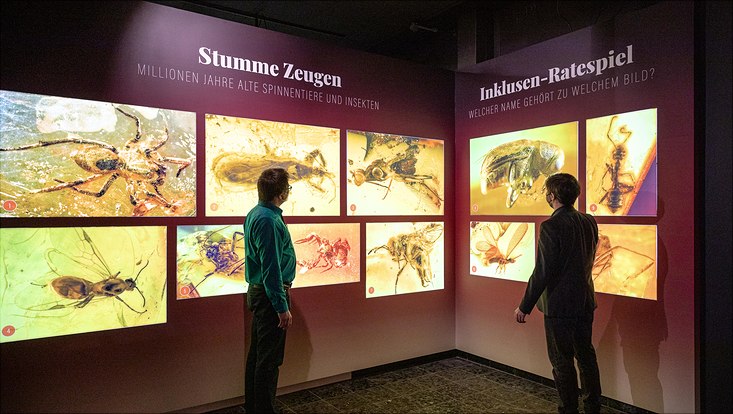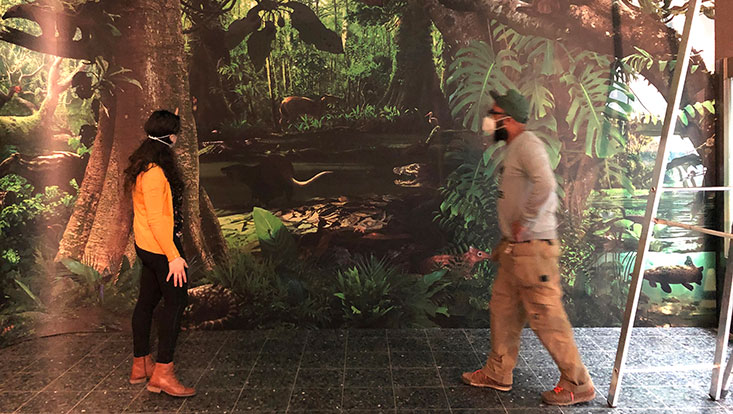
Paleoclimate research: Back to the future
8 April 2021

Photo: UHH, Hansen
Ulrich Kotthoff (left) and Viktor Hartung (here in front of enlarged amber inclusions) developed the content of the Eocene exhibition.
Ulrich Kotthoff looks to the past to gain insights for the future. Pollen grains and single-celled organisms from marine and lake deposits, fossil insects and living creatures preserved in amber provide the head of the Geological-Paleontological Museum at CeNak with detailed reports on life in past Earth eras such as the Eocene. This allows him to reconstruct past ecosystems and determine past climate changes.
Ulrich Kotthoff in an interview:
The Eocene dates back more than 33 million years. How accurately can paleontologists study life so long ago?
From the perspective of a geoscientist, the Eocene is not that far back. We therefore have relatively many "shop windows" into that time. These include deep-sea deposits, but also sedimentary rocks from earlier lakes that can be studied through research drilling. The Messel pit near Darmstadt is a good example of such a lake. Large-scale research excavations can also be carried out there.
What clues do drillings and excavations give you about the structure of ecosystems at that time?
To stay with the Messel example: In the sedimentary rocks, we researchers can find pollen grains and remains of other plant as well as microorganisms. These allow us to reconstruct the vegetation around the former lake as well as the microflora and fauna within the former water body. Since usually the older deposits are at the bottom, we get an overview of what the flora and fauna looked like at what time. During the excavations, we paleontologists can also find larger fossils of plants and animals and thus obtain the comprehensive picture of an ecosystem - from the lurking crocodile and the small prehistoric horse to the vine and the freshwater algae.
What insights do amber provide you in addition to the fossils from Messel?
In Europe, for example also in Bitterfeld, we have some large amber deposits, which are probably only a little younger than the fossils from Messel. Danilo Harms from the Arachnology Department and I are currently examining these deposits for the arachnids they contain as part of a project. In amber, evidence of larger creatures is rare, but very well preserved smaller animals, plant remains and fungi can be discovered. In addition, amber again contains animals that tend not to be found in lake deposits. So amber represents another important showcase into the ecosystems of the past.
Why are you studying arachnids in particular?
Some arachnid groups preserved in amber have not yet been studied in detail. Thanks to a cooperation with the German Electron Synchrotron DESY, we now have high-resolution scans that provide us with completely new insights. For example, using these three-dimensional images, we have already been able to identify a family of spiders that was previously only known from the present day - now we know that they already existed in the Eocene.
Some arachnids have very specific requirements for ecosystems and the climate. Therefore, they can help us to test and, if necessary, optimize climate reconstructions for the Eocene, for example, and to better understand the development of habitats.
And what can we now learn from the Eocene with regard to current climate warming?
Paleoclimate researchers arrive at congruent conclusions via very different reconstruction methods: In the Eocene, especially the early Eocene, we had significantly warmer conditions coupled with higher levels of atmospheric CO2 and other greenhouse gases. Sea level was about 50 to 100 meters higher than today. Northern Germany was at least partially covered by the precursor of today's North Sea. We had rather subtropical to tropical conditions here. For example, crocodiles and heat-loving turtles lived in the Messel area.
So with the Eocene, we have a possible scenario of how the world might evolve if we are not careful with greenhouse gas emissions. However, it is important to keep in mind that the continents were still arranged somewhat differently in the Eocene. In addition, some of the current human-influenced changes are occurring very rapidly.


